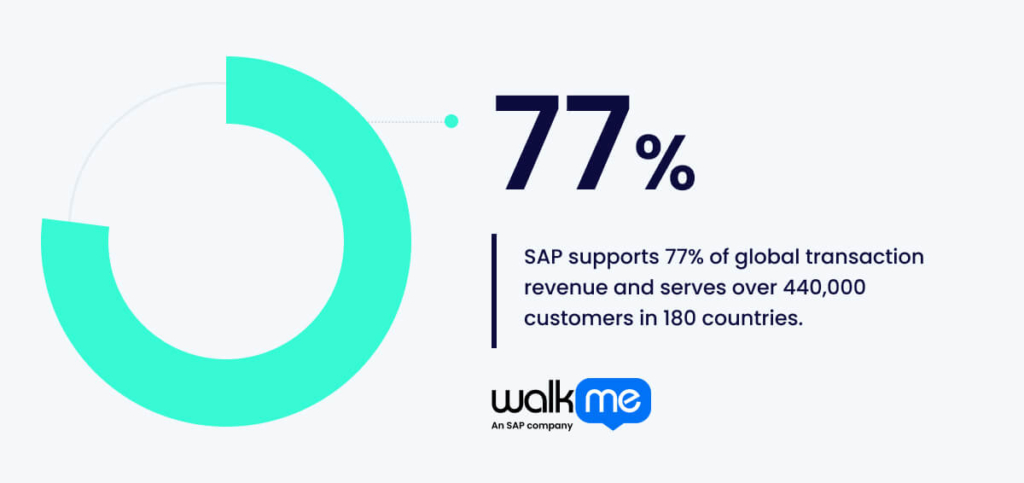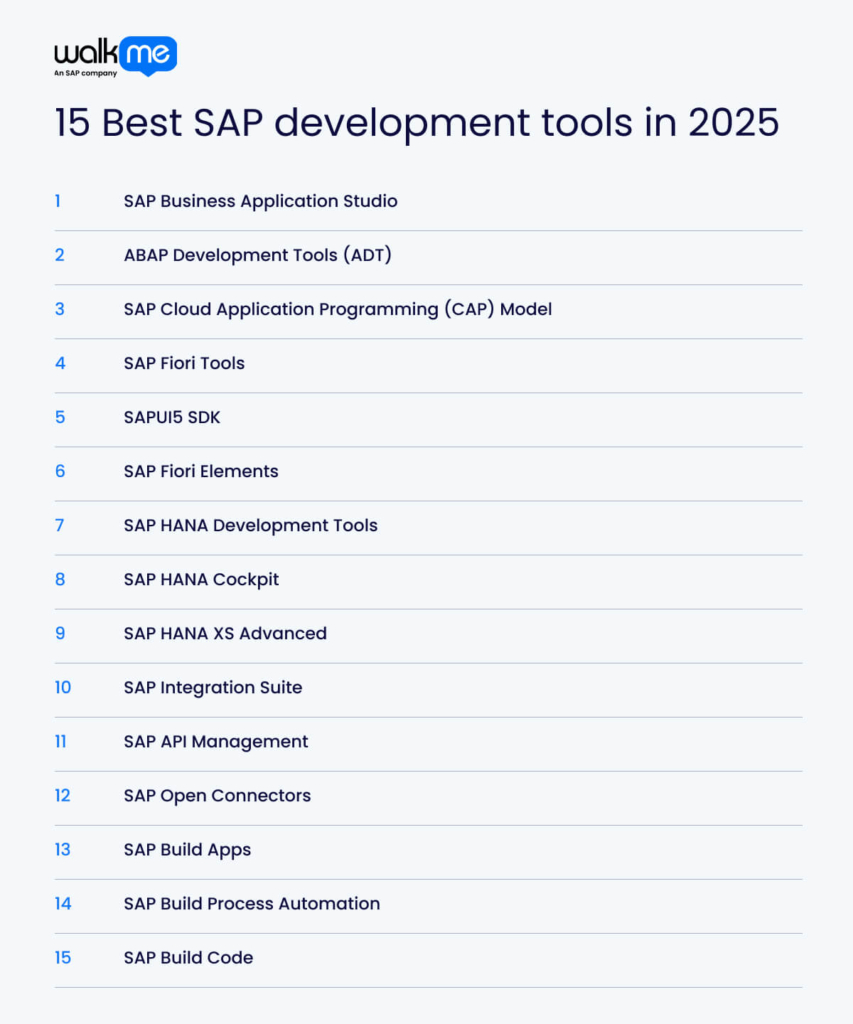SAP supports 77% of global transaction revenue and serves over 440,000 customers in 180 countries.

Behind that scale is a set of development tools that help businesses adapt, integrate, and build on SAP’s core platforms. Forward-thinking teams use these tools to reshape business models, accelerate innovation cycles, and transform ERP from a system of record into a system of advantage.
As SAP shifts to a cloud ecosystem, flexible development is becoming a major advantage. Knowing how SAP development tools work is essential for leaders focused on IT modernization, customization, and resilience.
This article highlights 15 top SAP development tools across five categories, covering how they help build, integrate, and automate more innovative solutions.
What are SAP development tools?
SAP development tools help businesses shape and connect their systems to meet specific needs. They include ABAP tools for custom backend logic, SAP Business Application Studio for cloud apps, and low-code app development for fast, visual builds.
These tools suit complex environments where security, performance, and compliance are essential. Developers use them to support key functions in finance, supply chain management, and manufacturing.
Unlike general platforms, SAP tools operate within the system’s core, which lowers risk and improves stability.
With the right setup, teams can launch features such as automated invoice matching or predictive maintenance without impacting critical processes, including billing and inventory control.

Application development tools
The first housing category on the list is application development tools. These are useful for building, customizing, and extending SAP applications to meet distinctive business requirements.
Tools like ABAP Development and SAP Cloud Application Programming Model support everything from backend logic to full-stack services on SAP Business Technology Platform.
Let’s take a closer look at SAP application development tools:
1. SAP Business Application Studio
SAP Business Application Studio is a cloud-based development environment made for building SAP applications. Developers can create, test, and deploy full-stack apps right within SAP’s Business Technology Platform. It supports multiple languages, such as Java and JavaScript, and features built-in tools for debugging and collaboration.
Unlike older desktop tools, its cloud-based setup allows teams to work together and scale easily. It simplifies complex tasks, such as building apps like SAP Fiori or creating microservices. This flexibility enables companies to deliver new customer solutions faster, aligning with the pace of digital adoption without infrastructure or setup delays.
2. ABAP Development Tools (ADT)
ABAP Development Tools (ADT), available in Eclipse, bring modern features to traditional ABAP programming. ADT includes strong code editing, testing, and refactoring tools, all within a familiar interface. It helps developers make updates to current SAP systems and build new features for SAP S/4HANA. This means that legacy systems stay stable, while changes can happen quickly.
ADT also works with version control and transport tools to match enterprise standards. Its focus on performance and long-term stability makes it a solid choice for cloud projects. Developers can rely on ADT to keep core ERP functions running while making progress toward digital transformation.
3. SAP Cloud Application Programming (CAP) Model
The SAP Cloud Application Programming (CAP) Model helps developers build cloud-ready SAP apps. It includes reusable templates, built-in services, and support for Java and JavaScript. CAP handles technical aspects such as storage and security, allowing developers to focus on writing business logic. This reduces the need for repetitive work and accelerates the delivery process.
Its modular setup fits well with SAP’s shift to microservices and event-based applications. CAP also supports collaboration between IT and business teams, making it easier to build and test ideas quickly. It’s designed for flexible, scalable development within SAP’s Business Technology Platform.
User interface and experience tools
The next category is user interface and experience tools. These tools streamline the design and development of intuitive interfaces, helping to deliver seamless and engaging user experiences across SAP applications.
They enable developers and designers to create consistent, accessible, and visually appealing applications that improve productivity and satisfaction.
Let’s take a closer look at SAP development tools for user interface and experience:
4. SAP Fiori Tools
SAP Fiori Tools help developers quickly design and build SAP Fiori apps. They are available as Visual Studio Code plugins, offering templates, code suggestions, and live previews. These tools keep user interfaces consistent with SAP’s design rules and speed up development without lowering quality.
Working with SAP Business Technology Platform, Fiori tools make it easy to deploy and test apps in the cloud. Automating routine steps means teams focus on crafting better user experiences that improve adoption across organizations.
5. SAPUI5 SDK
The SAPUI5 SDK provides a large library of ready-made UI components for building responsive web apps in SAP environments. It includes controls, layouts, and data-binding features that ensure apps work well on desktops and mobiles. Designed for consistency and accessibility, SAPUI5 lets developers create rich, dynamic interfaces for complex business processes.
Its modular design improves app performance by loading only the needed resources. Built-in support for multiple languages helps companies deploy globally. SAPUI5 is the core technology behind SAP Fiori, enabling developers to deliver powerful user experiences.
6. SAP Fiori Elements
SAP Fiori Elements simplifies the process of building user interfaces by providing ready-made templates for common applications, such as lists, object pages, and reports. These templates generate full SAP Fiori apps, saving developers from writing UI code by hand.
Each app built with Fiori Elements follows SAP’s design and accessibility standards. The templates connect directly with OData services, allowing apps to grow and adjust as backend data changes. This metadata-based setup reduces development time and maintains responsive interfaces. It also helps teams deliver clean, maintainable apps faster, with tools that fit into existing SAP digital workflows.
Database and data modeling tools
Moving deeper into the development stack, database and data modeling tools form the foundation of data-driven applications.
These tools shape how information is structured, stored, and retrieved across SAP landscapes. They support high-performance modeling, data integration, and access across both transactional and analytical environments.
Let’s take a closer look at SAP development tools for databases and data modelling:
7. SAP HANA Development Tools
SAP HANA Development Tools give developers what they need to build data-focused apps directly on the HANA platform. These tools work in Eclipse or SAP Business Application Studio and support building calculation views and full-stack services. Developers can write fast, efficient code using SQLScript, close to where the data lives.
Built for SAP’s in-memory setup, the tools offer quick performance for transactional tasks. Teams use them to turn raw data into live insights while keeping systems scalable and well-connected.
8. SAP HANA Cockpit
SAP HANA Cockpit is a browser-based tool that helps teams manage and monitor SAP HANA systems in real-time. It displays database performance, system health, memory usage, and user activity through an intuitive dashboard. Admins can back up data, adjust system settings, and track queries without needing scripts or command-line tools.
Role-based access keeps the environment secure, while built-in alerts help teams fix issues before they cause disruption. Whether managing one database or many, Cockpit simplifies daily tasks. It’s essential for any organization that runs critical business data on SAP HANA and needs consistent, stable performance.
9. SAP HANA XS Advanced
SAP HANA XS Advanced is a built-in runtime that supports microservices and cloud-ready apps. It separates application logic from the database, making it easier to scale, update, and manage software over time. Developers can use common languages like Java and Node.js while still tapping into HANA’s real-time data power.
XS Advanced includes DevOps features like version control and container-based deployment, all within the SAP environment. It’s a smart option for teams updating legacy systems while staying within the SAP ecosystem.
Integration tools
Our penultimate category is integration tools. Within SAP development, these tools are designed to link SAP systems with external applications, data sources, and services.
They’re well-suited for automating end-to-end processes, syncing data across platforms, and enabling communication between cloud and on-premise environments.
Let’s take a closer look at SAP development tools for integration:
10. SAP Integration Suite
SAP Integration Suite links SAP systems with cloud services, on-premise apps, and third-party platforms. It includes tools for workflow automation, data mapping, and system communication. Developers can use prebuilt templates and connectors through a simple interface to build and manage integrations.
The suite supports APIs, B2B messaging, and event triggers. Built on SAP Business Technology Platform, it includes built-in security and centralized monitoring. Whether connecting finance tools or syncing data with partners, Integration Suite helps teams manage complex systems more easily.
11. SAP API Management
SAP API Management gives teams full control over how systems share data. It lets developers create, manage, and secure APIs that connect SAP with other apps and services. Tools for authentication, traffic control, and analytics protect sensitive data while keeping it accessible to the right users.
Businesses use it to expose backend data to mobile apps, partners, or internal tools, without sacrificing security or speed. It works with both REST and OData APIs and integrates directly into SAP Integration Suite.
12. SAP Open Connectors
SAP Open Connectors simplify integration between SAP and over 160 popular third-party apps like Salesforce, Slack, Stripe, and HubSpot. Instead of building custom code for each platform, developers use prebuilt connectors with a consistent setup. These connectors handle authentication, API calls, and data formatting behind the scenes, saving time and reducing errors.
Businesses can launch integrations faster while keeping everything connected to SAP. Open Connectors also manages rate limits and standardizes API behavior. This means developers don’t need to learn each system’s quirks. It’s a powerful way to extend SAP with modern tools while keeping integration fast and manageable.
Automation and low-code tools
Last but not least on our list of SAP development tools are automation and low-code tools, which represent a shift toward more accessible application development and process improvement.
These tools bridge the gap between IT and business, accelerating delivery while unlocking agility.
Let’s take a closer look at SAP development tools for automation and low-code:
13. SAP Build Apps
SAP Build Apps enables users to create powerful business applications without requiring advanced coding skills. Its drag-and-drop interface makes building web and mobile apps fast and simple. The tool works smoothly with SAP systems and external data sources on SAP’s Business Technology Platform.
Both IT teams and citizen developers can collaborate, speeding up app delivery while maintaining tight security and governance. SAP Build Apps lowers the barrier to innovation, enabling organizations to turn ideas into real, usable apps that meet business needs and enhance agility.
14. SAP Build Process Automation
SAP Build Process Automation helps simplify complex tasks by combining robotic process automation (RPA), workflow design, and AI automation. Users can build process flows visually, connecting SAP and non-SAP systems with little to no coding. This reduces manual work and helps expedite tasks like approvals.
Real-time monitoring reveals where delays occur, making it easier to optimize workflows. Automating everyday steps gives teams more time to focus on bigger priorities. The tool also helps maintain consistent processes and ensures alignment with company rules, reshaping the layout of daily work.
15. SAP Build Code
SAP Build Code offers a low-code platform that accelerates app development without limiting flexibility. Developers use visual editors, reusable components, and templates to build applications while supporting JavaScript for custom logic. It integrates deeply with SAP’s cloud platform, ensuring apps are secure, scalable, and easy to maintain.
Collaboration between IT and business users enables SAP Build Code to reduce delays and accelerate innovation. Its modular setup supports connections to SAP and external services, making it ideal for extending existing systems or creating new features that align perfectly with evolving goals.
The essential SAP development tools for success
That concludes our overview of the top 15 SAP development tools, organized across five essential housing categories.
Selecting the right tools and strategies requires a clear understanding of your organization’s challenges and future objectives. Companies that use SAP development tools gain increased agility, faster innovation cycles, and improved business resilience.
The difference between successful digital transformation and costly setbacks often hinges on choosing the right development approach.
Investing time in aligning SAP digital tools with business goals ensures solutions are scalable and adaptable, a key factor in sustaining competitive advantage and driving long-term growth.
FAQs
Low-code and no-code SAP tools enable users to create apps with minimal or no coding experience. They help teams work together efficiently and reduce the time required to build new software. These tools enable users to change or add features as their needs change quickly. They reduce the need to wait for busy IT specialists. This means that new ideas can be turned into real apps faster and with less hassle.
SAP tools utilize in-memory databases, such as SAP HANA, to handle data instantly. Developers create live data models and APIs that show current information. This helps users receive updates promptly. Companies can monitor their systems and identify problems or changes as they occur. It helps them react more quickly and keep things running smoothly.
Developers need to learn ABAP and SQLScript for working with data and business logic. Knowing how to use SAP’s cloud platform and tools like Fiori enables the creation of user-friendly apps. Learning how to connect different systems and manage APIs also matters. Low-code skills can speed up development. Together, these skills enable developers to build useful and reliable apps for SAP environments.

